When considering a healthy lifestyle, the first idea that may come to mind may be going to the gym or eating clean. Many factors beyond calorie counting, drinking green smoothies, and striving to add just a little more weight to the barbell while lifting at the gym contribute to feeling and being healthy. Many neglect the importance of mental and spiritual well-being as part of a healthy life.
The key to overall well-being begins in the mind. In this article, we will highlight:
- Ways to ground yourself with natural remedies for a healthy mind, body, and spirit
- Examples of what a healthy lifestyle can look like
- Life Grows Green products that will enhance your journey into overall health
Mind and Body

Americans are expected to spend as much as $33.25 billion on gyms, health clubs, fitness centers, and studios in 2021, reports Runrepeat.com. With these impressive financial expectations, the gyms are outfitted with various classes that target every part of the body, including the mind.
Some of these gyms contain uncommon elements catering to a new crowd, like built-in yoga studios. Behind the studio doors, the chaos of the gym is filtered out. The lights are dimmed—a candle dances to music that seems to pull all the bustling energy to a place of peace. Curiosity leads members to walk in, roll out a mat and take their sneakers off in preparation for a completely different kind of workout.
“I remembered as I laid motionless on the floor. The trainer told me to exhale. This brought focus to steadying the breath, first, by exhaling the day’s stress, anger, and anxiety, then inhaling deep cleansing breaths over several minutes. As I laid there, a sense of guilt came over me. I didn’t view this as exercise.” A gym member notes. The experience is unusual for some, especially those expecting a typical gym workout.
“No sweat, no grunting…but much like the Zumba class being conducted in the pool a few doors down, just because the impact doesn’t hurt doesn’t mean everything inside of you isn’t being engaged. The guilt slowly drifted away as I realized that this simple meditation was a gift for the soul.”
The mind is such a powerful tool that it must be incorporated when discussing health. It is, in fact, the key to health, as all decisions and actions (even snap ones) start in the mind. Health is not just about exercise and food. It encompasses a diet of all things consumed, physically and emotionally.
Additionally, health is:
- What you expose yourself to
- Who/what you listen to
- What you choose to watch
- What you surround yourself with
- What you hold on to
- Activities you engage in, both physical and mental
The Seven Chakras
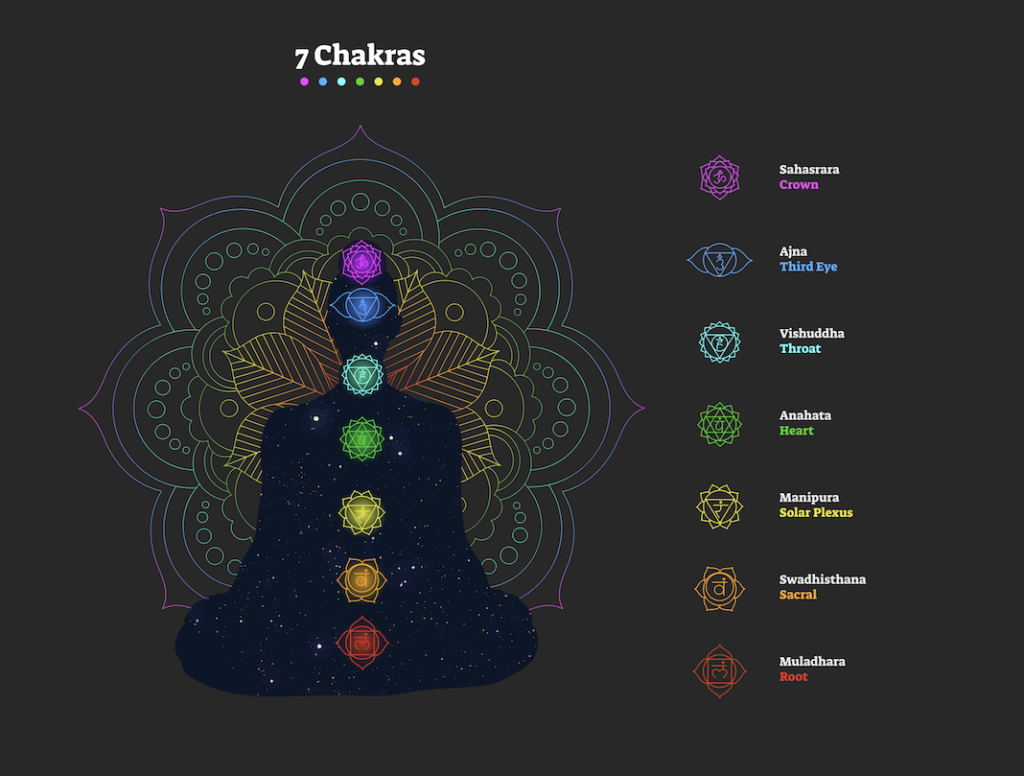
The phrase “aligning chakras” was mentioned soothingly as the trainer brought the class’s attention back to focus. Chakras are thought of as energy centers that help us understand the movement of thoughts and forces throughout our bodies. The Sanskrit word “Chakra” (spelled cakra) is a system that traces back between 1500 and 500 BC. The term means “spinning discs” that spin throughout the body.
There are as many as 114 with the seven major discs that run along the spine:
- Crown control spirituality, consciousness, inspiration (Sahasrara)
- Third Eye control intuition, imagination, vision (Anja)
- Throat communication, honesty (Vishuddha)
- Heart emotions, relationships (Anahata)
- Solar Plexus control confidence (Manipura)
- Sacral control desires (Svadhisthana)
- Root control foundation, manifestation (Muladhara)
With the understanding of chakra placement in the body, you have a tool to comprehend your victories and struggles in life in the context of something greater. Often, signs that the chakra are out of alignment are dismissed as regular occurrences. For example, the Heart Chakra can display that it’s out of alignment by creating pain in the upper back and surfacing in the form of anxiety and depression. Likewise, imbalances in the root chakra display themselves as insomnia, poor circulation, and clumsiness.
Healing hands
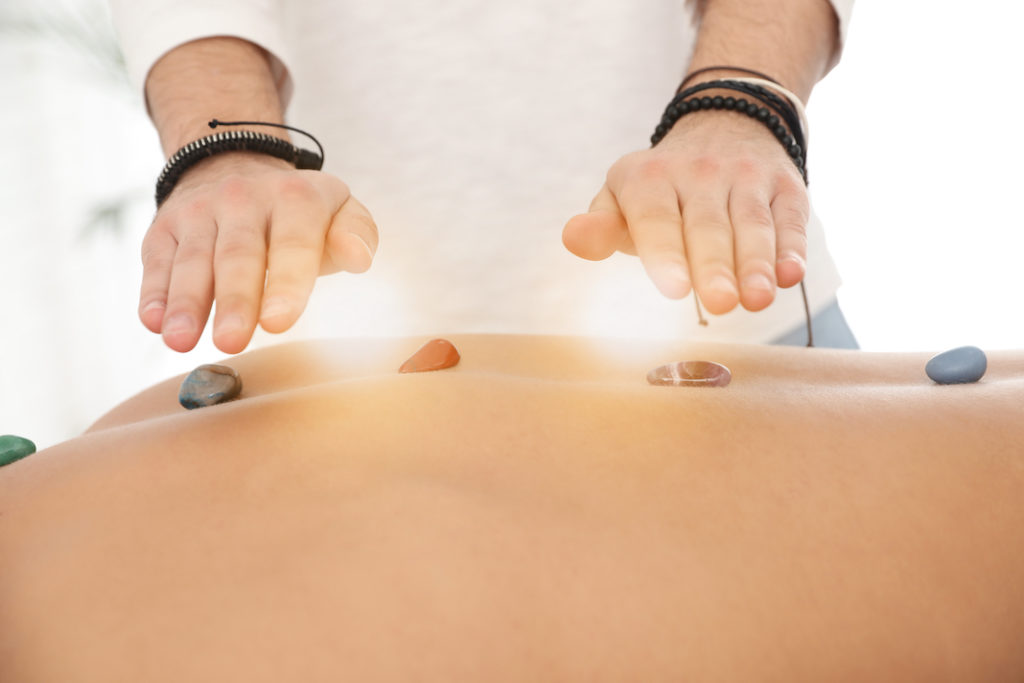
How do you ask for a hand redirecting your attention and fixing blocked energies? Reiki appeared on mainstream radars only a few years ago. It quickly became essential to the natural healing community and is a service that’s offered even in hospitals. The concept of a nearly touch-less massage may baffle those new to its existence, but not to those who the have experienced it themselves.
One Reiki healer skeptically once gave this natural healing method a chance, only to decide later it was a gift so powerful that she wanted to share it with others. Photos online reveal she’s even practiced on dogs.
Now, she teaches Reiki as a guest speaker for seminars hoping to spread the word by enlightening one person at a time. Some of her clients are healing their broken hearts after losing loved ones and fully credited Reiki as the source for their healing.
This practice isn’t new by any means. Reiki is a combination of two words that combine Chinese and Japanese words. “Rei” is supernatural, and “Ki,” vital energy, was a practice created by a lay Monk named Mikao Usui around 1920.
Reiki also incorporates crystals as part of healing according to a clients’ needs.
- Crown Chakra – Clear Quartz
- Third Eye Chakra – Amethyst
- Throat Chakra – Lapis Lazuli
- Heart Chakra – Rose Quartz
- Solar Plexus Chakra – Citrine
- Sacral Chakra – Carnelian
- Root Chakra – Hematite
Sensory deprivation tanks

Another form of natural healing involves the use of a deprivation tank. It was invented in 1954 by neuropsychiatrist Dr. John C. Lilly, who studied the effects of sensory deprivation on the brain. After several tweaks and redesigns, the first commercial aquatic float tank was debuted in 1972 and can now be found worldwide.
The salt water-filled tank, upon first observation, may look similar to a tanning bed. A client described his experience with the following words:
“I stepped inside, shut off the lights, and began to float in what felt like an adult-sized womb. It was a bit unnerving at first, especially as I kept intently listening for sound outside of the saltwater lapping around my body. I searched for some light that might bleed through the cracks, but I was sealed completely in my own world.”
He hadn’t ever been somewhere so dark and so quiet. He imagined this was similar to what a friend meant when describing how quiet it is in mastering rooms for his professional recordings. “It was so quiet; I could hear the blood pumping through my veins.” He understood what that meant now.
“I tried to see light or color but could only see them if I shut my eyes to retrieve specific grades of purple from memory. As I trusted my environment more and more and got over my initial anxiousness, I was led to some of the places I haven’t seen in a very long time. I didn’t ask my mind to go there, but I walked through the front door of my childhood home.”
“I could see the wallpaper and almost hear the paper bend back as I pressed my fingers on the edges where the glue lifted… then, through the entryway, through the saloon doors that led to the kitchen. I moved over to the lines on the wall where I’d ask several times a day if someone would measure me to see if I’d gotten any taller.”
Tiny magical details, right down to his bedroom’s 70s burnt orange carpet’s texture (the thickness and faded spots), all rose up as real as the last time he’d walked out the door. It is incredible to think these insignificant details lay discarded until woken by focused attention.
These details disconnect from daily relevance, yet they hide in the back of one’s mind like a buried treasure waiting for you to follow the map. Some writers use this aquatic float tank to stimulate thoughts to override writer’s block.
Military and law enforcement use this hour as a way to manage the post-traumatic stress disorder they’ve experienced. “When I left the float tank, my steps were light, and I felt recharged. My childhood home is no longer standing, but I’m so glad I got to visit it once again, even if only in my mind.”
Forest Bathing
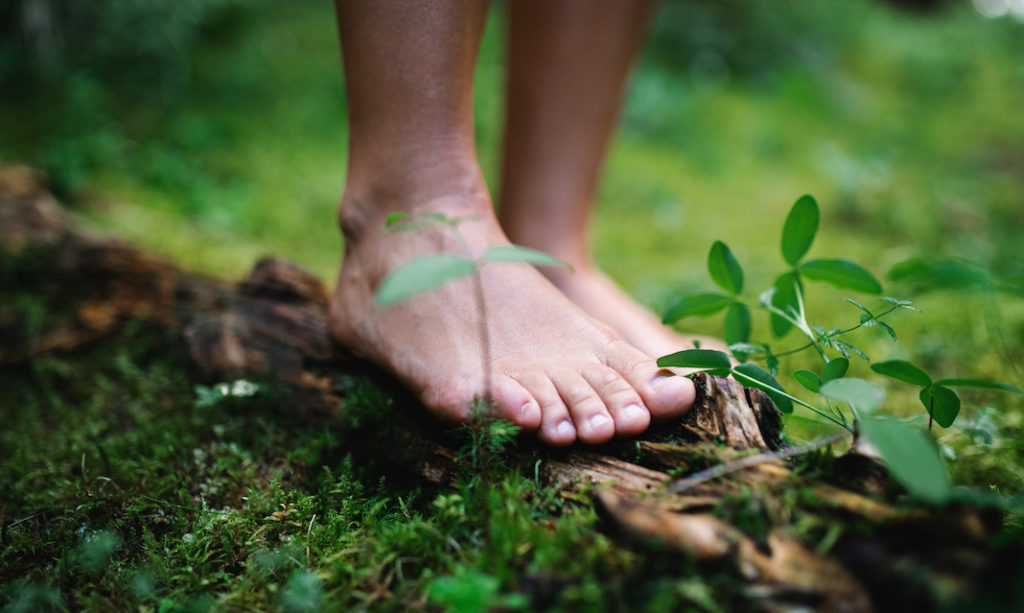
Forest bathing or Shinrin-yoking is a term that originally came from Japan in the 1980s. It focused on the importance of being in nature to promote mental health to counter the high rate of depression and suicide.
Its purpose is to rid you of your distractions and have you present to the world around you while filling your senses with the magnificent gifts nature has to offer.
There’s always movement and music in the air as the birds sing to the sky from a green canopy of foliage that perfectly conceals winged companions or a breeze that slips its way through leaves, causing the sun to cast a flickering display on the forest floor.
There’s even beauty to be found in nature, even in the things that scare you. Take, for example, a log you have to balance on to cross the water. There’s beauty in accepting that by being undistracted, you will become aware that cleansing will open our spirits to nature as our ultimate teacher.
Nature is always in communication, constantly growing, cheating death, dying, and recycling into a new life. We can’t control her; we can only impact her. If we treat her well, she will return the gift abundantly in lessons along the way.
You may begin to see yourself in the broken tree that still grows despite the trauma it has been through. You may see yourself in the bug you move out of the way to avoid stepping on it because its existence deserves to be acknowledged.
Only you can unlock the journey that will ultimately lead to spiritual growth and peace of mind. This is what it means to bathe in the forest.
This experience is not limited to wild, international destinations. Running along the East coast is a trail that’s as long and challenging as it is breathtaking. If you are able to walk the entire journey from Springer Mountain in Georgia to Mount Katahdin in Maine, this means the voyage has given you many lessons to carry forward.
Benton Mackay, a land-use planner, created the 2,190 miles of this trail. A shining example of the in-depth planning that captured some of the most beautiful views the east coast has to offer is a portion of the hike named “Stairway To Heaven.” This stretch of the Appalachian features rock scrambling that will give an intense workout with an often tricky climb.
Yes, it is difficult, but it’s worth the sweat to see the view when you reach the top. It was Earl Shaffer who, in 1948, was the first to complete the entire hike. He explained, “it was to walk the army out of [his] system.” He was fresh from serving in the military in World War II and processing the aftermath internally at the time.
Seeing this tiny portion of the trail makes one wonder what he must have seen on the path less taken. Without realizing it, he was the first to practice Shinrin-yoking on the Appalachian Trail.
In recent years, you may have noticed more and more articles acknowledging the importance of mental health. What once seemed taboo or improper to mention in social gatherings came to the forefront with national acknowledgments about the importance of mental health and suicide awareness.
Apps such as HeadSpace give nightly routines the added mindfulness that comes with listening to serene tracks to help release tension and aid in relaxation. Other apps, such as Therapeer, allow users to vent and be a source of comfort to ailing peers.
Small local businesses and big-box stores such as IKEA have all played roles in normalizing conversations involving mental health by experimenting on how negative environments impact plants.
The Experiment
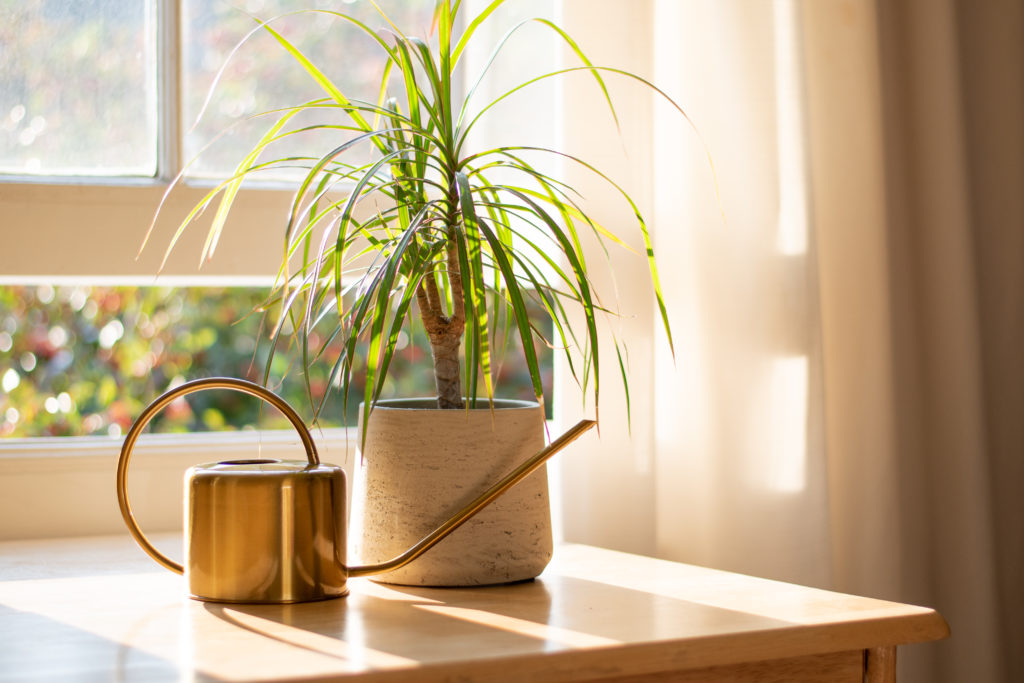
To see how negativity impacts humans, IKEA decided to experiment on two identical Dracaena plants. Although separated, they were placed in the same room, with a glass enclosure. They received similar amounts of light, water, and attention.
The only difference is that the students pre-recorded positive, uplifting affirmation messages to play for one plant. While with the other was played pre-recorded messages of negativity. Phrases such as “you’re beautiful” to “You’re ugly. Are you even a plant?”
After a few days passed, it was evident that of the two the plant with the more positive environment thrived, while the other was slowly turning yellow and wilting. The experiment was called, “Bully A Plant.”
While the experiment itself cannot be taken at surface value for its relationship between physical and psychological health, especially considering the differences between plants and human beings, there are takeaways that we can still apply. What happens when we repeat awful things to ourselves? Are we impacting our health by the passing thoughts we are experiencing?
If you tell yourself any one message enough times, it will take root within you. Over time, you will hold it as a truth that will take a fair amount of work to eradicate. Speak kindly to yourself in your thoughts. Explore yourself and reflect health from the inside out, whether it takes place at home, on the Appalachian, or in a sensory deprivation tank.
There is beauty everywhere. Take in the wonder of the spectacular moments unfolding all around you, created because of you. Reflect deeply. Know that you are valuable, even if it takes work to realize and understand it. Most importantly, love and forgive yourself. It is the key to lifting your limits.
In conclusion
Health moves from your mind to your body. Here at Life Grows Green, we believe in providing natural products that aid your ventures like our Premium CBD salve in lavender eucalyptus. This THC-free moisturizer and soothes targeted areas with high-quality CBD oils sourced right from the earth. It’s infused with lavender and eucalyptus to enhance your therapeutic experiences. Check out our shop to purchase.
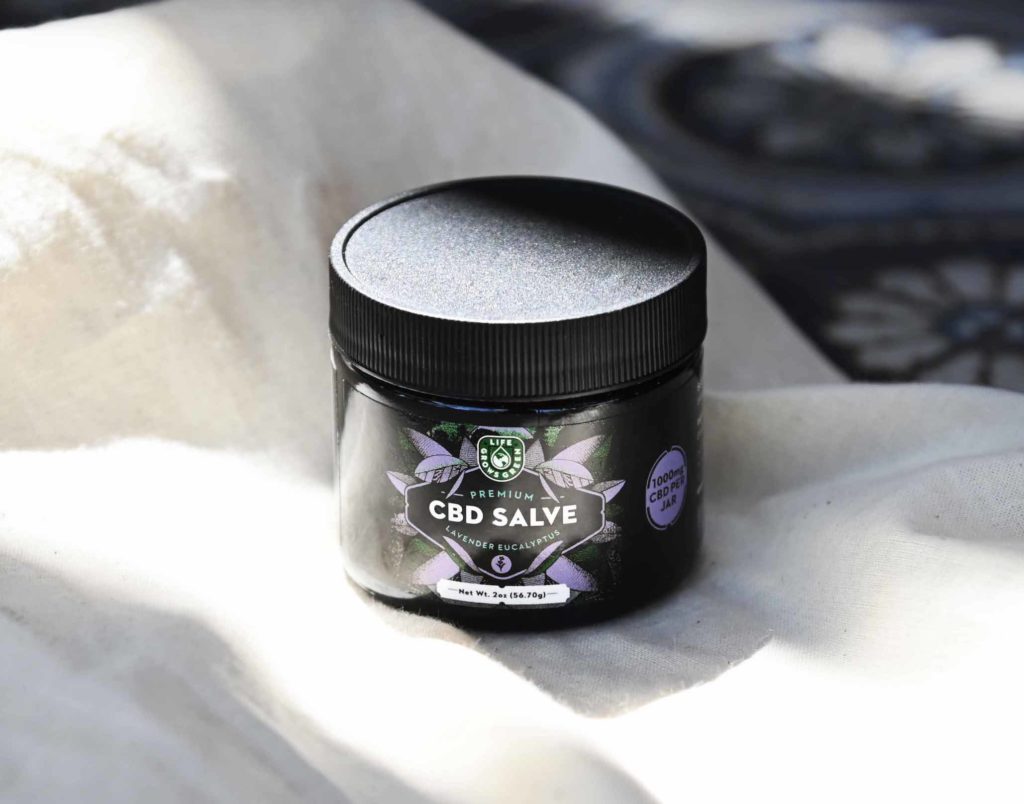
How do you maintain your daily balance?
